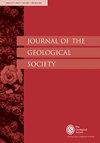Albarrana山脉域(西南伊比利亚地块)碎屑锆石颗粒中的Hf同位素:Eburnean与太古宙基底特征
IF 3
3区 地球科学
Q2 GEOSCIENCES, MULTIDISCIPLINARY
引用次数: 0
摘要
本文研究了伊比利亚西南地块Albarrana域下古生代变质沉积层序中锆石碎屑的Lu-Hf数据。我们提供了关于它们的起源、大陆地壳演化记录和地质亲和性的新信息。该地块的碎屑锆石U-Pb数据显示了两个主要的年龄群,年龄峰值为c. 595 Ma和c. 1.90 Ga。埃迪卡拉纪事件被解释为一个岩浆弧,其中年轻岩浆侵入冈瓦纳的Eburnean基底,并可能与之混合。弧的不同演化阶段可能与新元古代-寒武纪早期的卡多米亚造山运动有关。古元古代锆石群与鄂布兰造山运动相对应。来自Eburnean枯竭地幔的岩浆部分侵入了一个更古老的基底,导致了一个早期的混合过程。εHf同位素组成与伊比利亚中部可能有密切关系,表明埃迪卡拉—寒武纪的地质背景相同,而古元古代的地质背景不同。补充资料:https://doi.org/10.6084/m9.figshare.c.6420215本文章由计算机程序翻译,如有差异,请以英文原文为准。
Hf isotopes in detrital zircon grains of the Sierra Albarrana Domain (SW Iberian Massif): Eburnean vs. Archaean basement signatures
This study presents Lu–Hf data on detrital zircon grains from the Lower Paleozoic metasedimentary successions of the Sierra Albarrana Domain (SW Iberian Massif). We provide new information about their origin, record of continental crustal evolution, and geological affinity. Previous detrital zircon U–Pb data in this terrane reveal two main age populations, with age peaks at c. 595 Ma and c. 1.90 Ga. The Ediacaran events are interpreted to represent a magmatic arc with input of juvenile magmas intruding into the Eburnean basement of Gondwana, and probably mixing with it. The different evolutionary stages of the arc were probably linked to the Cadomian Orogeny during Neoproterozoic-earliest Cambrian times. The Paleoproterozoic zircon population corresponds to the Eburnean orogeny. The magmas derived from an Eburnean depleted mantle partly intruded an older basement, leading to an incipient mixing process. εHf isotopic compositions indicate a possible affinity with the Central Iberian Zone suggesting a common geological setting during Ediacaran-Cambrian times, but different during the Paleoproterozoic.
Supplementary material:
https://doi.org/10.6084/m9.figshare.c.6420215
求助全文
通过发布文献求助,成功后即可免费获取论文全文。
去求助
来源期刊

Journal of the Geological Society
地学-地球科学综合
CiteScore
6.00
自引率
3.70%
发文量
68
审稿时长
6-12 weeks
期刊介绍:
Journal of the Geological Society (JGS) is owned and published by the Geological Society of London.
JGS publishes topical, high-quality recent research across the full range of Earth Sciences. Papers are interdisciplinary in nature and emphasize the development of an understanding of fundamental geological processes. Broad interest articles that refer to regional studies, but which extend beyond their geographical context are also welcomed.
Each year JGS presents the ‘JGS Early Career Award'' for papers published in the journal, which rewards the writing of well-written, exciting papers from early career geologists.
The journal publishes research and invited review articles, discussion papers and thematic sets.
 求助内容:
求助内容: 应助结果提醒方式:
应助结果提醒方式:


